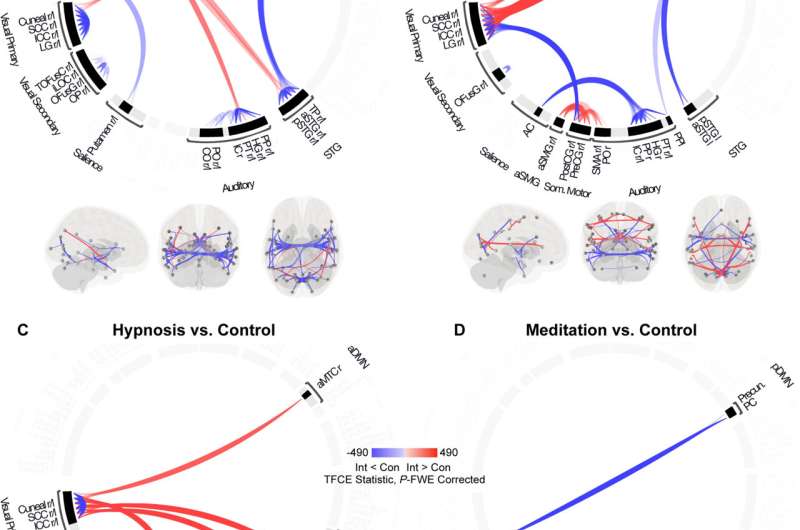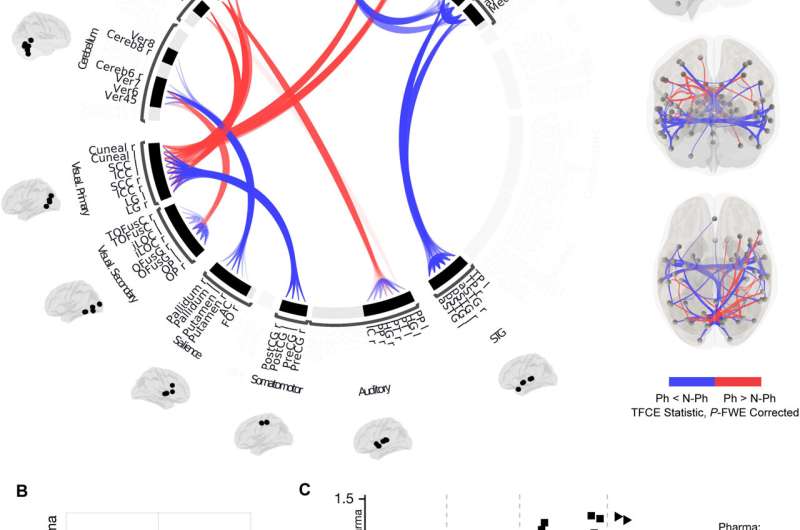Exploring what happens in the brain under the influence of psychedelics, while meditating and during hypnosis

Changes in a person's "normal" mental state after taking drugs, while meditating, during hypnosis or due to specific medical conditions have been a topic of study for several years now. Some of these mental changes, which are known as altered states of consciousness, have been found to have potentially beneficial effects, reducing stress and fostering greater well-being.
Researchers at University of Zurich's Psychiatric Hospital have recently been exploring the potential of psychedelic drugs, such as psilocybin and lysergic acid diethylamide (LSD) for treating depression and other mental disorders. In a recent paper published in Biological Psychiatry: Cognitive Neuroscience and Neuroimaging, they compared the brains of people who had taken psychedelics to those of others who were meditating or were hypnotized.
"Our group has plenty of experience studying altered states," Nathalie Rieser, one of the researchers who carried out the study, told Medical Xpress. "We have been investigating the effects of psychedelics on the brain in various studies, given that altered states of consciousness are becoming increasingly relevant in the treatment of psychiatric disorders. Anecdotally, people often report similarities in experiences induced by hypnosis, meditation, or psychedelics. However, our neurobiological understanding of these states is only just evolving."
While many studies looked at individual altered states of consciousness and how they manifest in the brain, comparisons between these states remain scarce. Rieser and her colleagues wished to fill this gap in the literature, by comparing the neural correlates of psychedelics, meditation and hypnosis.
"We did not know if the same neurobiological alterations give rise to the experience of all altered states or whether these states are different on a brain-level," Rieser said.
Rather than conducting a single experiment that collectively involved psychedelics, meditation and hypnosis, the researchers analyzed datasets conducted during four distinct experimental trials. The first two trials examined the effects of two different psychedelic drugs on the brain, namely psilocybin and LSD, while the last two focused on hypnosis and meditation.

"We combined four different datasets that were collected at the Psychiatric University Hospital in Zurich using the same MRI-scanner," Rieser explained. "For the psychedelic studies, we included healthy participants who subsequently received psilocybin, LSD, or a placebo, whereas the meditation and hypnosis studies were conducted with participants who were experts in the respective field to make sure they can reach the state in an MR environment."
During the team's four experimental trials, all participants were asked to simply lay inside an MRI scanner without completing any task or engaging in any activity. The MRI scanner recorded their brain activity both while they were in a normal state of consciousness and under the altered state of consciousness relevant to that trial (i.e., after taking psychedelics, while meditating or while under hypnosis).
"We analyzed the participants' brain activity throughout the whole brain and investigated whether different brain areas work together in a distinct way compared to the baseline scan," Rieser said. "Our findings showed that even though psilocybin, LSD, meditation and hypnosis induce overlapping subjective effects, the underlying brain changes are distinct."
The findings gathered by this team of researchers suggest that while some might report having similar experiences or feelings under these different states of consciousness, what is happening in their brain is actually very different. While psilocybin and LSD appeared to produce similar brain activity, the changes they induced were markedly different from those observed during meditation or hypnosis. This suggests that psychedelics, meditation and hypnosis have distinct underlying mechanisms of action and overall different effects on the brain.
Overall, these results suggest that these three distinct states may have synergistic therapeutic effects and may not therapeutically substitute each other. In the future, they could pave the way for further investigations of their unique strengths and benefits, potentially informing the development of new promising therapeutic strategies for psychiatric disorders.
"We are now simultaneously working on investigating mechanisms of action of psychedelics in healthy controls as well as their clinical application in the treatment of patients with alcohol use disorder and major depressive disorder," Rieser added. "We are assessing their efficacy and exploring brain, behavioral, and cognitive changes in response to psychedelic-assisted therapy. The current study is informing future investigations on optimizing psychedelic-assisted therapy."
More information: Flora F. Moujaes et al, Comparing neural correlates of consciousness: from psychedelics to hypnosis and meditation, Biological Psychiatry: Cognitive Neuroscience and Neuroimaging (2023). DOI: 10.1016/j.bpsc.2023.07.003
© 2023 Science X NetworkPersonal psychedelic use may be common among psychedelic therapists
No comments:
Post a Comment